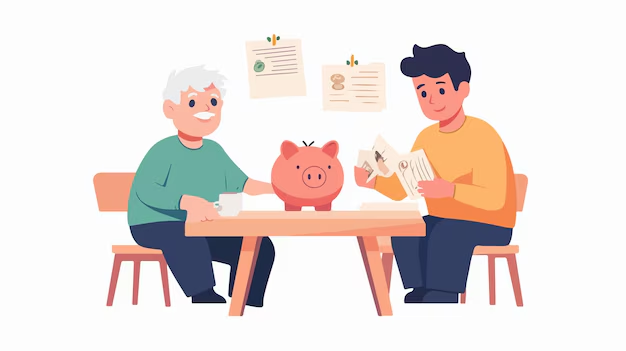Essential Pre-Retirement Planning: What You Must Consider Before Retiring

Introduction
When you’re in your 20s or 30s, retirement might seem like a distant thought. Your priorities likely center around building a career, gaining new experiences, and enjoying life. However, the reality is that starting to plan for retirement early can set you up for a more secure and stress-free future. By taking the right steps now, you can gradually grow your savings and set yourself on the path to financial independence. So, how can you effectively plan for retirement in your 20s and 30s? Let’s break it down.
Table of Contents
1. Why Retirement Planning Matters Early
Retirement may seem far away, but the biggest advantage of planning early is time. After retirement, your income stops, but your expenses continue, and sometimes go up due to health and lifestyle needs. The sooner you plan for retirement, the more you can benefit from compound interest, where your money earns interest on interest. Starting with a small amount now can turn into a large sum over time, giving you more freedom in the future.
The key:
The sooner you start, the more time your money has to grow, which will reduce financial stress in the future.
Also Read : Finance for Beginners : Tips and Tricks for Financial Success
2. Build a Budget and Cultivate Saving Habits
Competent retirement planning starts with understanding your current financial situation. The first step is to create a budget that helps you track your income and expenses and identify areas where you can save.
- Track your income and expenses: First, make a detailed list of your earnings and expenses. This will give you a clear picture of your financial habits.
- Follow the 50/30/20 rule: This rule suggests that you allocate 50% of your income to essentials (such as housing and food), 30% to discretionary expenses (such as entertainment and travel), and 20% to savings and investments. This simple strategy can guide you toward better financial stability.
Key Takeaway:
Building good saving habits today will provide you with a financial cushion in the future. By following simple budgeting rules, you can set aside money for retirement while still enjoying life.
3. Choose the Right Retirement Investment Options
Once you have developed saving habits, the next step is to invest your money wisely. Here are some easy and effective long-term investment options:
- Public Provident Fund (PPF): This is a very safe and long-term savings scheme. Investing in it also gives you tax benefits and it gives a stable return.
- National Pension System (NPS): It is a government pension scheme that provides regular income after retirement and also offers tax benefits.
- Mutual Funds and SIPs: If you are willing to take a little risk, investing in mutual funds through SIPs can give you good returns in the long term.
Key Takeaway:
Diversifying your investments into safe and slightly riskier assets can help balance your portfolio and maximize returns over time.
Also Read : Personal Finance Tips and Tricks : For Better Money Management
4. Leverage Compound Interest
When it comes to your retirement assets, the magic of growth is a really powerful instrument. Because you get interest on both your principle and the interest you have previously earned, it allows you to grow your money exponentially over time. This explain that your money rises more than once. Consequently, you will have greater financial independence in retirement if you begin saving earlier. In the end, you won’t have to worry about money and may enjoy life in the future.
Key Takeaway:
The earlier you invest, the more you can take advantage of compound interest, which can exponentially increase your savings.
5. Eliminate Debt
Debt can put a hindrance in your retirement plans, especially when you don’t manage it properly. High-interest debts, such as credit cards and personal loans, can slowly eat away at your savings.
So, make it your priority to get rid of debt. When you repay these debts early, your financial position will be strong, and you will be able to focus more on building your retirement fund. Imagine how relaxing it would be to plan for retirement without debt!
Think of getting rid of debt as a fresh start. It is an important step towards making your future secure and prosperous. With a little effort, you can build a strong fund for your retirement.
Key Takeaway:
Becoming debt-free early will allow you to invest more towards your future and improve your overall financial health.
6. Set Up an Emergency Fund
An emergency fund is a crucial part of your financial security. It is essential to prepare it so that whenever an unexpected problem arises, like a health emergency or job loss, you are prepared.
Make sure you save at least six months of living expenses. This will enable you to face tough times without denting your retirement investments. Imagine, if a sudden crisis strikes, you will have a backup that will give you peace of mind.
An emergency fund not only strengthens your financial position, but it also helps you meet your retirement goals in the future. It is one step you can take to make your future secure and comfortable.
Key Takeaway:
Having a well-funded emergency savings account provides peace of mind and prevents you from dipping into your retirement savings.
Also Read : 10 Easy Ways to Make Money Online
7. Get Insurance for Protection
Insurance plays a vital role in securing your and your family’s future.
- Life Insurance: If you are the primary breadwinner of your family, life insurance ensures that your loved ones’ financial situation is protected in your absence. It provides your family with a stability they can lean on even in tough times.
- Health Insurance: Medical expenses can be very high, and health insurance saves you from spending your savings on medical bills. It provides you with protection so that you can get the necessary treatment when needed without worrying that your financial situation will be affected.
Key Takeaway:
Insurance not only safeguards you but also preserves your retirement savings by covering large unexpected expenses.
8. Set Clear Retirement Goals
Your retirement plan should not just be about saving money; it should also take into account the lifestyle you want to live after retirement. Do you want to travel, pursue a hobby, or buy a new home? When you set specific goals, you can tailor your savings plan to help you enjoy the retirement you envision.
Key Takeaway:
Define what you want your retirement to look like and make financial decisions today to support that future.
9. Review Your Investments Regularly
Retirement planning is not a one-time task. It is extremely important that you review your investments regularly to ensure they are in line with your goals. As market conditions change or changes occur in your life, you may need to adjust your investments.
Key Takeaway:
Regularly reassess your financial strategy to stay on track and take advantage of better opportunities as they arise.
Also Read : Freelancing 101: How to Start Your Own Business
10. Plan for Taxes
Tax planning is an important part of preparing for retirement. Use tax-saving tools, such as deductions under Section 80C and 80D, to reduce your tax liability and grow your savings.
With the right tax planning, you will not only be able to protect your savings but also be able to accumulate more for retirement. This way, you can grow your retirement fund and reduce future worries.
Key Takeaway:
Smart tax planning can help you retain more of your income and invest it for a better future.
Conclusion
Planning for retirement in your 20s and 30s is a smart step towards financial freedom. The earlier you start, the more time you give yourself to grow your savings, benefit from compound interest, and prepare for the future. With the right planning, you can not only secure your present but also ensure a happy, stress-free retirement. So, don’t delay—start planning today!
Here are some frequently asked questions (FAQs) about retirement planning:
Q1. Why is it important to start retirement planning early?
Starting early allows you to take advantage of compound interest, which helps your savings grow significantly over time. The earlier you start saving, the more time your money has to grow.
Q2. What are the key steps to create a retirement plan?
Key steps include assessing your current financial situation, determining your retirement goals, estimating future expenses, and choosing suitable investment options.
Q3. What are some common retirement investment options?
Common options include employer-sponsored retirement accounts (like 401(k) plans), Individual Retirement Accounts (IRAs), mutual funds, and stocks.
Q4. How much should I save for retirement?
A general rule of thumb is to save at least 15% of your income, including any employer match. However, your specific needs may vary based on your retirement goals.

















